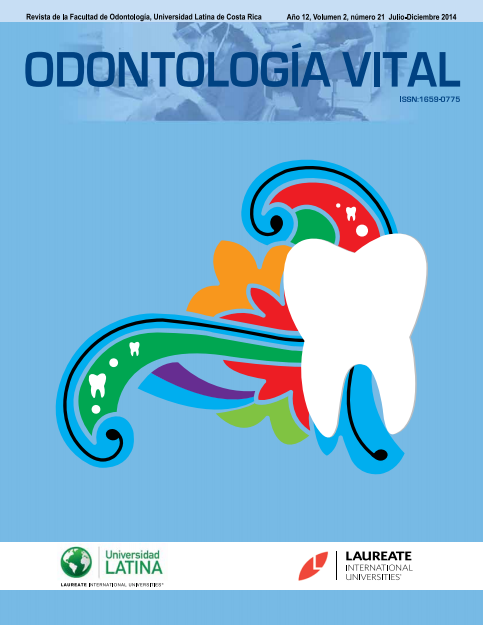Use of biodentine in the treatment of cervical idiopathic reabsorption: Clinical report
DOI:
https://doi.org/10.59334/ROV.v2i21.290Keywords:
Idiopathic cervical resorption, endodontics, Biodentine®Abstract
Dental resorption is a common consequence after an injury or irritation of the periodontal ligament and/ or tooth pulp. The course of dental resorption involves a complex interaction between inflammatory cells, resorption cells, and hard tissue structures. Key cells involved in resorption are of the clastic type, including osteoclasts and odontoclasts.
Among the types of dental resorption are: internal resorption, external resorption, and idiopathic cervical resorption. The aim of this paper is to present a clinical case where Biodentine® is used when managing idiopathic cervical resorption.
Downloads
References
American Association of Endodontists. (2003). Glossary: contemporary terminology for Endodontics. Chicago.
Bergmans L, Van Cleynenbreugel J, Verbeken E, Wevers M, Van Meerbeek B, Lambrechts P. (2002). Cervical external root resorption in vital teeth. X-ray microfocus tomographical and histopathological case study. J Clin Periodon-tol; 29: 580–585. https://doi.org/10.1034/j.1600-051X.2002.290615.x
Burak, M., Bilge, M. y Unverdi, A. (2013). Effect of various endodontic irrigants on the push-out bond strength of Biodentine and conventional root perforation repair materials. JOE. pp. 1-5
Cohen S. Burns R. (2002). Vías de la pulpa. Octava Edición. Elsevier Science. Madrid, España.
Fuss Z, Tsesis I, Lin S. (2003). Root resorption- diagnosis, classification and treatment choices based on stimula-tion factors. Dent Traumatol; 19: 175-182. https://doi.org/10.1034/j.1600-9657.2003.00192.x
Gómez M, Campos A. (1999). Histología y embriología bucodental. Buenos Aires. Editorial Médica Panamerica-na. Pág. 175-225
Han L, Okiji T. (2011). Uptake of calcium and silicon released from calcium silicate–based endodontic materials into root canal dentine. International Endodontic Journal. pp.1-7. https://doi.org/10.1111/j.1365-2591.2011.01924.x
Heithersay, G. (2004). Invasive cervical resorption. Endodontic Topics, 7, 73–92. https://doi.org/10.1111/j.1601-1546.2004.00060.x
Ingle J, Bakland L. (1996). Endodoncia. 4ta edición. Editorial McGraw- Hill Interamericana. Capítulo 5.
Lindhe J. (2003). Periodontología clínica e implantología odontológica. Editorial Panamericana, Tercera edición. Nageswar, R.. (2011). Endodoncia avanzada. Capítulo 20. Editorial Amolca
Ne R, Witherspoon D, Gutmann J. (1999). Tooth resorption. Quintessence Int; 30: 9-25
Patel, S, Ricucci, D, Durak, C y Tay, F. (2010). Internal root resorption: a review. J Endod;36:1107–1121. https://doi.org/10.1016/j.joen.2010.03.014
Pelegrí, M. (2011). Biodentine: Eficaz tecnología en biosilicatos. Canal Abierto, Revista de la Sociedad de En-dodoncia de Chile. 24:16-19
Septodont, Biodentine™ Active Biosilicate Technology™, Scientific File
Soares, J. y Goldberg, F. (2002). Endodoncia técnica y fundamentos. Editorial Médica Panamericana. Madrid: España. pp.303-305.
Trope, M. (2002). Root resorption due to dental trauma. Endodontic Topics, 1, 79-100. https://doi.org/10.1034/j.1601-1546.2002.10106.x
Zhou, H., Shen, Y., Wang, Z., Li, L., Zheng, Y.,H€akkinen, L. y Haapasalo, M. (2013). In vitro cytotoxicity evaluation of a novel root repair material. JOE. pp. 1-6. https://doi.org/10.1016/j.joen.2012.11.026
Symposium, (2010). Biodentine. L’information dentaire n° 37 - 27 octobre 2010
Padelle-Plasse, N. (2011). Propiedades físicoquímicas Biodentine®. Universidad de París.
Downloads
Published
How to Cite
Issue
Section
License
Copyright (c) 2014 Odontología Vital

This work is licensed under a Creative Commons Attribution 4.0 International License.
Authors who publish with Odontología Vital agree to the following terms:
- Authors retain the copyright and grant Universidad Latina de Costa Rica the right of first publication, with the work simultaneously licensed under a Creative Commons Attribution 4.0 International license (CC BY 4.0) that allows others to share the work with an acknowledgement of the work's authorship and initial publication in this journal.
- Authors are able to enter into separate, additional contractual arrangements for the non-exclusive distribution of the Odontología Vital's published version of the work (e.g., post it to an institutional repository or publish it in a book), with an acknowledgement of its initial publication.
- Authors are permitted and encouraged to post their work online (e.g., in institutional repositories or on their website) prior to and during the submission process, as it can lead to productive exchanges, as well as earlier and greater citation of published work.
Métricas alternativas











